Jason Hughes
Chairman, CEO, and owner of Hughes Marino
For more than 20 years, Jason Hughes and his wife Shay have been very influential in the commercial real estate industry. With roots originally in San Diego (where Hughes Marino is the largest exclusive tenant and buyer representation company), the tenant representation firm has become a prominent player in the industry with offices throughout the nation. As market leaders, Jason and Shay have focused on providing deeper client services than ever experienced in the industry before, adding service and results guarantees to all of their customer relationships.
Recognized as a key figure in the tenant representation field, Jason Hughes pioneered new legislation known as the real estate broker Dual Agency Disclosure Bill, or SB 1171, which was signed into law by Governor Brown in August 2014 and went into effect on January 1, 2015. The new state law increases transparency and fairness for California commercial tenants, who now must be advised in writing when working with a broker who represents both tenants and landlords, creating a potential conflict of interest.
Over the years, Jason Hughes has transacted leases and purchases for tens of millions of square feet. He has experience negotiating complex and high-value leases; early renegotiations; expansion and contraction negotiations; office, hotel, and condominium purchases; participating loan structuring; lease and loan workouts; government negotiations; anchor high-rise lease negotiations; build-to-suit developments and project finance negotiations. Jason has negotiated many of the largest tenant lease transactions in Downtown San Diego, Sorrento Mesa, Carmel Valley, and the UTC area over the past thirty years—and is regarded as one of the preeminent commercial realty experts in San Diego and throughout California.
Jason Hughes received his Bachelor of Science in business administration from Pepperdine University and his Master of Business Administration in finance from the University of San Diego. He has also taken numerous executive programs at Harvard University, UCLA’s Anderson School of Business, and UCSD’s Rady School of Management, and he has appeared on numerous television programs and business publications as an industry expert.
 medium.com/@jason.hughes.san.diego?source=rss-e8538b612f3------2
medium.com/@jason.hughes.san.diego?source=rss-e8538b612f3------2

Gaining traction in a highly competitive industry takes more than a good marketing plan. Although that’s a key component, a forward-thinking business owner also seeks ways to stand out against his or her competitors. Strategically positioning the business as an authority in the field is also important.
In my company, I use a variety of tactics to help the business maintain a competitive edge. In other words, I never stop moving the company forward. Here are five ways to keep a business front and center in the eyes of potential clients and industry leaders.
Cultivate a Dynamic Company Culture
A vibrant company culture creates a workplace where every team member can thrive. At my company, we begin by providing a welcoming work setting that offers many of the comforts of home. Comfortable couches, along with colorful and eclectic décor and a game room, are par for the course with us.
Equally importantly, I regard our team members as our extended family. Everyone has something special to contribute, and we recognize those contributions at every company-wide meeting. I encourage team members’ growth by bringing in motivational speakers from various walks of life. I (and our COO) go the extra mile to provide team members with everything needed for personal and professional growth.
Become an Expert in a Single Niche
Standing out in a professional services marketplace is a challenge. New competitors are popping up everywhere. Established firms are looking for new service offerings and/or markets. In other words, even a respected services provider may find it tough to grow the business.
In my company, we don’t follow the herd. Instead, we focus our efforts in a niche that was previously ignored. We specialize in buyer and tenant representation for a wide variety of industries. We pull out all the stops for our clients, and we have numerous success stories under our belts. And because word travels fast, these successes lead to lots of referral business.
Utilize Game-Changing Technologies
Every day brings new technological advances applicable to many industries. One technology can provide my company’s clients with cost savings. The “Internet of Things” (or IoT) utilizes a network of chip-embedded objects that deliver targeted data. Analyzing the data can offer insights into building components’ potential failure rates. This can help to facilitate timely maintenance rather than expensive component repairs or replacements.
Another technology application can help my firm perform cost-effective construction management work. Although virtual reality is best known for gaming use, it also allows my project managers to virtually inspect construction projects. This minimizes the managers’ need for time-consuming site reviews that also result in added fuel expense.
Create Authentic Customer Relationships
Cultivating real person-to-person customer relationships means I “go the extra mile” for my clients. We often chat on the phone, and I frequently catch up with local clients over meals or Happy Hour refreshments. In fact, I really enjoy getting to know each client on a personal level.
From a business standpoint, I learn about each client’s challenges and find ways to help resolve them. Whether I’m working with a startup business or a major corporation, I use every resource at my disposal. I have a sincere desire to help them succeed, and I won’t let anything stop me from achieving that goal.
Regularly Speak at Industry Events
My company is recognized as an industry leader, and that’s certainly not by accident. In fact, I take every opportunity to position our firm as an authority in our field. Speaking at industry conferences and other large-scale events provides an ideal platform for achieving that goal. In addition, these high-profile activities help potential clients to link a face to the company name.
When I take the podium, I share our success stories, which can provide a springboard for conversations with potential clients. However, my addresses are more than just testimonials for our firm. I provide real, actionable success strategies that leaders in any industry can use. By sharing these tips with audiences, I “pay it forward” so everyone can win.
Changing economic and marketplace conditions mean I should frequently reassess my company’s competitive position. If necessary, I can refine these strategies or add more timely ones. However, my overall goal remains the same: Deliver top-tier client service that sets our company apart.

After two years of record low vacancy and 10% to 20% annual rent inflation for industrial properties around the country, it looks like the market is finally coming in to balance. Rumblings of recession and slower consumer demand have already caused some corporate tenants to put a pause on expansion requirements and slow down their demand for industrial space going into 2023. Landlords can no longer assume that Amazon will lease their new warehouse buildings as they are shifting to an owned real estate strategy, and reports in the last quarter signal that Amazon will put at least 10,000,000 SF of warehouse space on the market for sublease in markets like Southern California, Atlanta, New York and New Jersey. Additionally, a cooling housing market across the country is slowing down new construction, thus reducing the residential real estate industry’s supply chain requirements.
On the supply side, most metro areas across the United States have had an uptick of availability as compared to January of this year. However, this increase in availability is barely noticeable in some markets and availability remains extremely tight in most markets, particularly in Southern California where San Diego, Orange County and Los Angeles hover just above 3% availability and the Inland Empire is slightly above 5%. However, the largest increase occurred in Austin, which moved from 7% availability at the beginning of the year, to just over 10%. Joining Austin are the Denver and Dallas-Fort Worth metro areas, both with over 10% availability. Availability over 10% is the crossover point where markets start trending to be more tenant-favorable than landlord, although the rest of the country still leans strongly to the benefit of building owners. However, after three years of plunging vacancy and availability rates, any report showing an uptick in availability is worth paying attention to, and provides some promise to corporate tenants who are trying to keep their costs under control.
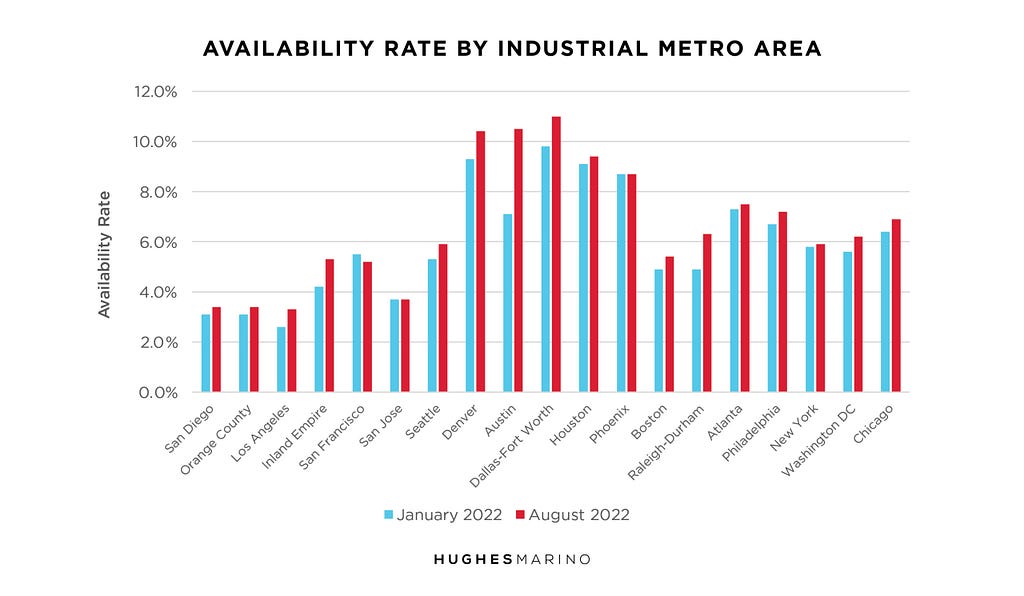
New Construction on the Rise
As we look to the future, it’s important to assess all of the new industrial supply coming online, as new construction folds into availability statistics. While most of the country remains relatively in balance with modest amounts of industrial construction, Dallas-Fort Worth tips to chart at 76,700,000 SF of new industrial space under construction. The Inland Empire has almost 40,000,000 SF coming online, which will create much needed opportunities for tenants that have leases expiring in 2023 and 2024. Phoenix has also become a hot market for new construction as the Southern California industrial market tightens up and tenants look for value alternatives in relative proximity of the ports in Southern California, where warehouse rents now range from $1.40 — $2.00 per square foot depending which part of Southern California a tenant might consider. Atlanta, being one of the top distribution markets in the country, and Chicago being the largest US industrial market, aren’t far behind, with over 35,000,000 SF of new construction coming on the market in each location. Considering how tight most of the major markets are around the United States, this new construction in itself should not create a softened market, other than in the Dallas-Fort Worth metro area that could easily be getting ahead of itself.
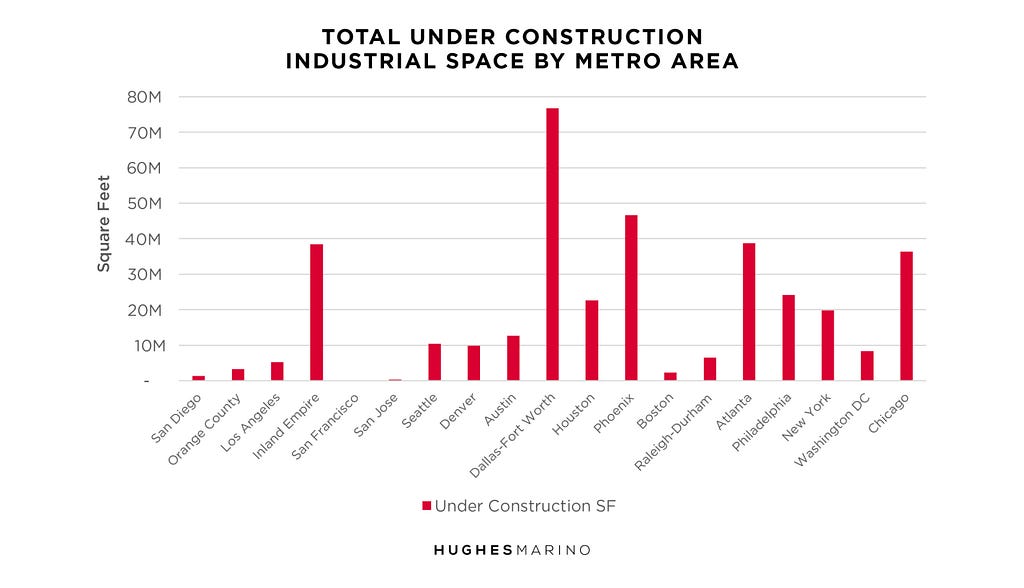
For industrial tenants looking to relocate or expand, companies are generally still facing limited supply and upward price pressure on rents, very much fanned by the brokerage community that represents the landlords throughout the country. Landlords and their brokers have been benefiting from a tightened national industrial market for several years, most recently exacerbated by unprecedented supply chain demands brought on by the shift of consumers to online purchasing during COVID. Tenants still need to plan in advance more than ever and need to be cautious in over-committing to too much space if they assume that growth projections are going to continue in the next three years based on what has occurred over the last three years. The critical success factor in these markets is to ensure that the tenant has independent and assertive representation on their side that’s willing to: challenge market momentum, push back on pricing gains and ensure that all opportunities are unveiled.
Originally published at https://hughesmarino.com on September 14, 2022.
Why Companies Should Provide Leadership Training for All Employees

Company-sponsored leadership training has long been available to C-suite executives. These intensive sessions ideally equip these senior leaders with the skills needed to move up to the next level. Historically, these training sessions have taken place at offsite venues or in a “crash course” in executive conference rooms.
By definition, lower-tier employees have traditionally been excluded from this higher-level training. If these workers were lucky, they might be tapped for a basic leadership skills class. These generic, watered-down courses offered minimal preparation for career advancement.
At my company, however, we do it differently. We hire team members who have already demonstrated leadership skills. Then, we bring in leadership and business experts who offer insights that can’t be found in business books.
Even better, we make these leadership training sessions available to every team member. In other words, I think everyone has leadership potential, and they should be given the tools to unlock it.
Typical Leadership Training Formats
Leadership training typically comes in multiple forms. Some formats are tailored to higher-level managers while others are open to employees of all levels.
Group Leadership Training
External companies typically offer these group leadership training courses. These sessions are usually geared to a general employee audience and include discussion along with leadership exercises.
Online Leadership Courses
Employees with varied schedules may appreciate an online leadership course. Targeted courses may be available for employees and managers. Each team member studies the exact same material and completes the course at their own pace.
External Leadership Conferences
Management-level leadership conferences often take place at hotels, convention centers, or other external venues. Attendees learn from leadership experts and enjoy networking opportunities.
Executive Leadership Courses
These elite leadership programs are designed for high-level executives tasked with training and managing other employees. The sessions often take place in professional meeting venues or retreat settings.
6 Benefits of “All-Hands” Leadership Training
Team members who receive leadership training will realize a host of professional and personal benefits. On the flip side, my company also sees multiple benefits. As a result, I’m pleased to say we enjoy a better competitive position in the industry.
Enhanced Employee Communication Skills
Exceptional leaders have stellar communication skills. Personally, I’m always looking for ways to more effectively present big-picture ideas to my team. Alternatively, I sometimes need to explain the nuts-and-bolts of a concept to employees with vastly different backgrounds.
Leadership training offers plenty of opportunities to become a better communicator. Leading a group project, or staffing the company booth at an event, are good examples. In truth, though, every minute a team member spends at the workplace offers opportunities for better communication.
Better Employee Decision-Making Abilities
Well-crafted leadership training teaches team members to make more effective decisions. Regardless of the subject, they’ll run a cost-benefit analysis and weigh the pros and cons of the issue. If they really dig deep, they’ll design and evaluate several possible decision outcomes. And when the team member reaches a decision, it’s likely the best possible outcome given the factors at play.
Higher Employee Productivity
Employees given leadership training opportunities will likely feel that their company values their contributions. In turn, these team members are more likely to do their jobs well and take pride in their work. When an entire workforce maintains this positive attitude, the company has a solid foundation for continued success.
At my company, we believe in every team member’s unlimited potential. We present them with every opportunity for growth. Company-wide leadership training is part of the package. And then we get out of the way.
More Effective Project Direction
Team members with good leadership skills are better equipped to manage often-complex projects. At my company, our projects typically have lots of moving parts. We need project managers who can keep their project on track. At the same time, they must ensure that everyone involved has the resources they need to succeed. And, they need to provide professional support to each member.
Our team members need to have confidence in their project manager’s ability to navigate obstacles and move forward. Good leadership training will accomplish all these objectives.
Better Risk and Change Management
Managing business risk and change are always a challenge. Examples of business risk include a changing economic environment and an evolving market landscape. In addition, other factors can change my company’s operating environment from day to day.
To effectively manage risk and change, I must think on my feet and take an “out-of-the-box” approach. Top-notch leadership training helps me to quickly analyze a situation and take decisive action based on the information available.
Increased Employee Retention
Employees who receive high-level leadership training may perceive that their company has high regard for their skills and potential contributions. Likewise, managers who receive proper leadership training are better equipped to motivate and manage their team.
Better employee retention, and a more stable workforce, may result from either scenario. And improved employee retention means my company spends less on hiring campaigns and recruitment agencies. And that’s certainly a win for everybody.
A Leadership Training Model That Works
For my company’s leadership training sessions, I find exceptional leaders who each travel their own path. Regardless of their industry or achievements, their insights can stop me in my tracks. I know my team members will also benefit from hearing these inspiring leaders. So, I invite each visionary to a company-wide meeting. Then, I sit back and watch the magic unfold.
The Art of the Real Estate Deal — Hughes Marino Denver

Coloring Creative on the Commercial Real Estate Canvas
I’m a corporate real estate broker with award-winning real estate advisory firm, Hughes Marino. We help business leaders make great real estate decisions for their growing teams.
I’m also an artist, which, as it turns out, informs my approach to leading high value projects for my clients. You see, when I create art, I always break it down into four stages:
- Stage 1: See things with absolute clarity
- Stage 2: Understand what it is that I am seeing (hint-this isn’t always obvious)
- Stage 3: Have a crystal-clear vision of what I intend to create
- Stage 4: Go for it, make art, do my thing as only I can do it
So, how does this apply in complex, high-value real estate projects?
1. See things clearly.
Some might call this ‘qualifying the opportunity.’ Be pragmatic, understand what is possible and what isn’t. Be clear-eyed as you head into new projects in order to set reasonable expectations, lay out all possibilities and be able to express these things clearly. We work with amazing people running remarkable companies. Our clients are busy, and they trust us to take the lead on their high-impact real estate planning and decision making. How we kick off a project sets the tone for everything that follows. So, let’s think things through and make sure we see and communicate a clear path ahead.
2. Understand what you are seeing.
As the market expert, I need to understand the context in which things are happening. I need to be a master of my marketplace. I know who your landlord is, I know the last three transactions they signed and I know the concessions they offered. I also know that the building is currently 40% vacant and their loan is coming due in the first quarter next year. I also know that on their last quarter’s investor conference call (because I listened in), they expressed confidence in raising their occupancy to at least an 80% level, which means they are under tremendous pressure to deliver on that promise and meet the street’s expectations. Point being-I know my market cold. This is just basic table stakes.
3. Have a clear vision of what you intend to create.
Here’s the thing. I am going to be negotiating this transaction on your behalf. You are the client, and the final decisions will be yours. It’s your space, and it’s your transaction. The only definition of success that matters is if, when we get to the finish line, you deem the project to be a success. So, I had better understand what you are looking to achieve and what matters most to you. I need to start by asking questions. As a mentor of mine often says, “prescription without diagnosis is malpractice.” This is what I mean by having a clear vision of what “we” intend to create. It is sometimes called Workplace Strategy, and it is about asking questions and gathering data from you, the client, in order to inform the work I will do on your behalf.
4. Do my thing as only I can do it.
Differentiation in the marketplace of ideas is, I believe, automatic. We are all different. I happen to be a people person. So, for me, this business of corporate real estate, bricks and mortar, isn’t about the buildings. It’s about the people. That’s just who I am. Let me show you how I approach this business of corporate real estate. Let me show you how I lead projects, solve problems and get things done.
Let’s make some art.
Anna Quattlebaum is a vice president of Hughes Marino, an award-winning commercial real estate company specializing in tenant representation and building purchases with offices across the country. Contact Anna at 1–844–662–6635 or anna@hughesmarino.com to learn more.
Originally published at https://hughesmarino.com on September 1, 2022.
Project Management Roundup: StepStone Group, Artiva Biotherapeutics, Hillel San Diego & More — Hughes Marino San Diego
As summer is in full swing, our Hughes Marino program, project and construction management team continues to work hard on many exciting projects around our communities. Here’s an inside look at some of the progress.
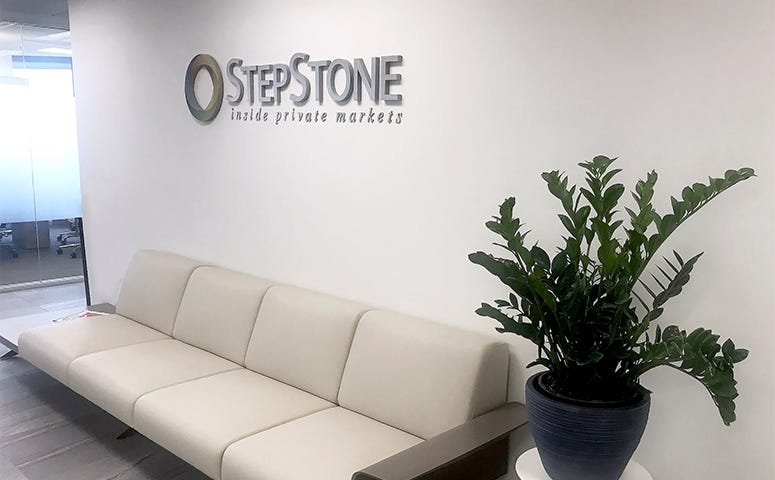
StepStone Group
StepStone Group is a global private market firm providing customized investments and advisory solutions to some of the most sophisticated investors in the world. They have offices in 23 cities across 14 countries, with a global operating platform and strong local teams that possess valuable regional insights.
Experiencing rapid growth, StepStone was determined to expand their footprint at University Town Center where Hughes Marino had previously helped them build out the 14–16 thfloors, to now include the 12 th-floor, 7,900 SF space. Their total office footprint is now an impressive 47,360 RSF, which features panoramic views of UTC. Hughes Marino was instrumental in the lease negotiations, planning, design, permitting and construction of the office space, all while meeting budget and client expectations. Partnering in the project were Gensler Architect, Bycor General Contractors and bkm OfficeWorks.
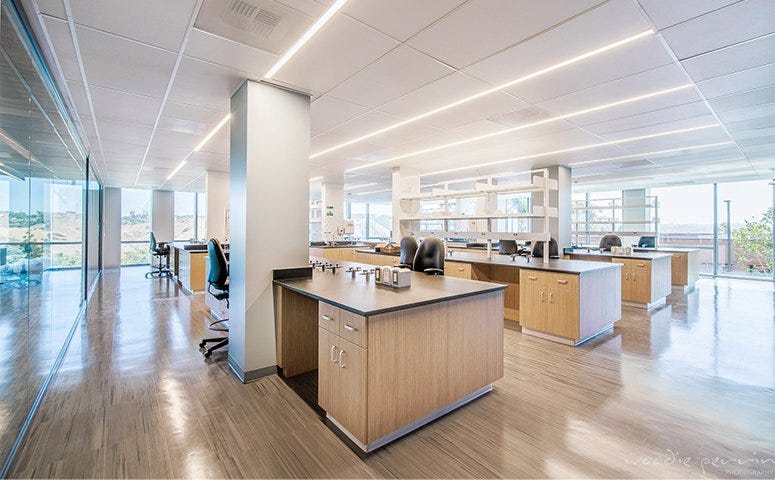
Artiva Biotherapeutics
Artiva Biotherapeutics is on a mission to deliver highly effective, off-the-shelf, allogeneic natural killer (NK) cell-based therapies, utilizing Manufacturing-First approaches, which are safe and accessible to cancer patients. Their new facility includes office space, research and process development laboratories, and will include a multi-suite custom-built Good Manufacturing Practice (GMP) space to support NK and CAR-NK cell production for Artiva’s pipeline development and clinical trial supply.
Our team, along with McFarlane Associates Architects and DPR Construction, was brought in to assist with the build-out of the 42,441 SF office and lab space, as well as the 9,180 SF of GMP space, including multiple ISO 7 clean rooms. The new facility will accommodate growth and support research and development for the continued work on cell therapies for cancer patients. Phase one of the project was completed on June 1, 2022, and we’re proud to help Artiva in their noble cause of cancer research.

Natural Alternatives International, Inc.
Natural Alternatives International Inc., has been an international leader in custom contract nutritional supplement manufacturing for nearly four decades, with a core mission to support and advance responsible nutrition on a global scale. With the help of the Hughes Marino brokerage team, NAI purchased a building for its corporate headquarters in the Carlsbad Research Center, located in Carlsbad, California. The project management team was then engaged to build a new 12,000 SF industrial mezzanine, 20,000 SF of manufacturing tenant improvements including clean rooms and dust collection systems, and remodel 10,000 SF of office space. Our team is working alongside Delawie Architects and Burger Construction, with completion expected in October 2022.
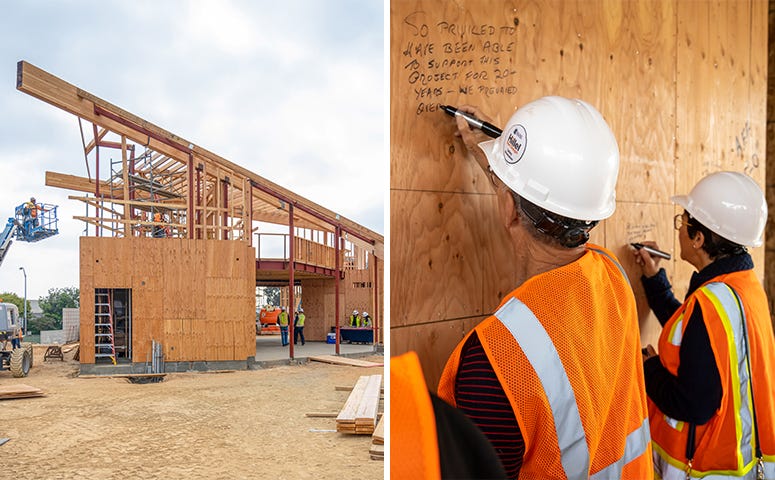
Hillel of San Diego
In May 2022, a group of supporters and students from Hillel San Diego attended a wall signing event to commemorate the construction of the new Beverly and Joseph Glickman Hillel Center, and write their well wishes on the plywood, as an homage to a time capsule. For Hillel San Diego, “these walls will nurture and sustain generations of Jewish young people filled with their own hopes and dreams. The footsteps of thousands of students will move from each of the three buildings and through the courtyard as they connect to their community and learn whom they want to be as Jewish adults in the world. When they face challenges, they will cling to the comfort and safety of these walls. When they celebrate, they will run to their friends on this holy ground.”
Eventually the plywood and the sentiments will be covered in drywall, but the sentiment of the well wishes will remain as inspiration for generations to come. Completion is expected to be in Fall 2022, and our team is honored to be a part of this meaningful community project. In addition to Hughes Marino, the project partners include the architect, MW Steele Group and Pacific Building Group.
We understand firsthand that construction management for any project often looks like a juggling act between architects, engineers, contractors, vendors and consultants, and with each client, we set a clear path forward, keeping their project on time and on budget at every phase. Our program, project and construction management team have extensive experience orchestrating the design and construction of virtually all types of projects-corporate, life science, residential, nonprofit, education, health services and much more. Need an honest opinion or would like to get our insights on your upcoming project? Just reach out, and we’ll be happy to help.
Hughes Marino’s industry leading Construction Management team has unmatched expertise in every type of commercial building project from tenant improvements to ground-up build-to-suits. With decades of experience in California and beyond, our project managers, engineers and LEED APs offer practical insights for the construction management professional.
Originally published at https://hughesmarino.com on August 23, 2022.
A CEO’s Take on Steve Kerr: Coaching the Golden State Warriors to Joy, Compassion, Competition & Mindfulness

As you may know, Steve Kerr has earned the reputation for being one of the finest coaches in the sport of professional basketball. In Kerr’s first five full seasons as head coach of the Golden State Warriors (2014–2019), the team made five consecutive NBA Finals appearances, won three championships, beat the single-season record for the most wins, climbed to the highest 5-season winning percentage in history, and has widespread acknowledgment as one of the game’s few dynasties. What many people don’t know is that Kerr’s only coaching experience before the Warriors was his 7th-grade son’s youth team-which one of my sons played on. Kerr was intense-even for 7th graders!
After an amazing five-year run, the 2019/2020 season was a much different story. The Warriors lost several key players to injury or transfer, and there was serious concern that the Warriors’ dynasty was over. A lot of focus was placed on how the team could get back on track for the season and become contenders to win the championship again, but Kerr argued that “for those in the organization, a different, less results-oriented definition was more immediately relevant. The goal should not be to win a certain number of games or to go deep into the playoffs. Instead, it should be to reaffirm the team’s culture and core values, and to find ways for the team to operate in accordance with them.” Kerr and his assistant coach Ron Adams wanted to evaluate the winning years-as well as the recent losing season-and figure out how to get the team on the right trajectory.
I recently shared one of Kerr’s quotes at a company team meeting: “We’re all from different backgrounds, but deep down we’re all the same. We’re all humans, we all have vulnerabilities, the difference is merely in our experiences and how those vulnerabilities are manifested.” I hadn’t before heard this spin on how people succeed. It resonated that our “experiences” of vulnerabilities and the corresponding manifestations are a key factor in one’s success. By understanding this, individuals-and teams-can overcome their prior internal limitations.
When Kerr first joined the Warriors as head coach, one of the first things he did was spend time with coach Pete Carroll of the Seattle Seahawks. After spending a couple of days with him, Carroll asked Kerr if he “had decided how you’re going to coach your team?” Kerr responded, “Like, what type of offense will we run?” Carroll said, “No. That’s not what matters most. The key is what type of culture you create, and what the guys feel every day when they show up at the arena.” Carroll told Kerr that it took him 10 years to figure out for himself that to succeed, “a coach has to have core values that come alive each and every day, and with which the players truly connect. Because if the players cannot connect, values just become words on a page.”
Kerr worked with Carroll to pare down an original list of values from ten to four, which he believed captured what was most important-joy, competition, compassion and mindfulness. As CEO of a company that lives and breathes our ten core values, his four truly resonated with me, and relate heavily to Hughes Marino’s own values, which I reflect upon below.
Joy
Kerr felt that it was imperative that the players not lose their love-and joy -of the game of basketball. He said, “even though now it has become for us a job, a career, something we’re paid to do, something we take very seriously, that sense of pleasure and play must not be lost.” He instituted loud music to be played during practice, which is surprisingly rare for basketball games, and promoted humor and practical jokes. Laughter abounds, which brings joy and builds comradery. What do you do as a leader in your business and in your personal life that brings you joy? At Hughes Marino, we have embraced joy in all we do with our core value #3; enjoy the journey. Create fun-as a team, for our clients, and with our families. Remember enthusiasm is contagious. Make it fun for our clients to work with us. Happy people make happy clients.
Competition
Kerr believes that the mindset required to win games has to be developed and trained during practice. As such, the team routinely embarks on shooting contests and scorekeeping during drills or scrimmages. They also foster competition outside of the arena with ping pong tournaments and team bowling nights. At Hughes Marino, we often have friendly competitions at broker team meetings and a thriving monthly billiards tournament in our offices that have garnered some of the best camaraderie among our team members. What have you implemented within your company and among your team to build the foundation of (friendly) competition?
Compassion
This is the most unusual of the four values, especially in the professional sporting world, where norms foster players to be tough and stoic, but Kerr believes this one to be the most important while at the same time the hardest. He believes it’s important to have compassion for not only your teammates, but your opponent as well. He says, “compassion starts with understanding that everyone, from superstar Steph Curry down to the last player on the bench, is probably dealing with something. It’s critical that we all acknowledge that while the nature of the adversity or struggle may differ somewhat, at the root level it’s still about vulnerability and shared human experience.” As business leaders we must lead by example, and make a conscious effort to build more compassion in our business strategies and interpersonal relationships with our teams.
Mindfulness
Kerr says mindfulness “may be the most elusive for us, in part because although we practice these things, neither myself nor anyone on my coaching staff is qualified to lead the group through yoga, breathing exercise or meditation.” Yet the “driving idea behind mindfulness is that there is immense value in being more present, and in understanding how to enter and remain in that state we often refer to as ‘ the zone.’”
Something else I found very valuable was the way Kerr handled his first days and weeks with the Warriors. He began by saying “you guys have already accomplished a lot. Let’s not change too much, but let’s find ways to be even better, especially on offense.” He wasn’t trying to change everything, he just wanted to work on a few areas to get better. What areas can you get better and be more mindful of daily? How can you implement mindfulness in your company?
For Kerr and his team, goal setting was process-driven rather than value-driven. Kerr never set a goal to win a specific number of games. Rather, he wanted to focus on process-driven goals, such as “be dominant on our home court” or “take more high-quality shots.” One example included a specific statistical goal: to pass the ball 300 times per game as a team-up from 250 the prior year. What process-driven goals can you commit to setting?
Especially relevant in today’s hybrid-work era, Kerr felt that getting the team together DAILY was, and continues to be, a priority. He believed that being together daily helped create a sense of normalcy around open and honest conversations. I too believe that more and more business leaders will realize how lacking hybrid work is for creating “a sense of normalcy around open and honest conversations” over time, along with all of the other limitations of not seeing your teammates regularly.
As evidenced above, Kerr is a fine example of a leader and embodies the concepts that are valuable in today’s ever-changing and hybrid-work era-something we can all learn from. The Harvard Business Review Store article goes further into details about the leadership style and success of the team, however, if I were to summarize the points to what I found most important, they would be:
- Our culture, core values and teamwork have never been more important.
- How can we use our challenges to empower us for greater success?
- Connection with each other is critical. Is each of us being a great teammate?
- Joy: are you having fun? If not, how can you change that?
- Competition: what contests can you and your respective office create to nourish this?
- Compassion: remember to have empathy for everyone, as everyone has their challenges in life.
- Mindfulness: how can we each find and stay in “the zone”? Please feel free to contact me and share your tips!
- Goal setting: what are a few process-driven goals you can create for yourself? For your teammates? For our company?
A final thought-as leaders, the buck stops with us and how we build our team, grow our companies and elevate our culture. We must lead by example, through competition, compassion, joy, mindfulness and more, as coach Kerr and Carroll have done so successfully over the years. By keeping these concepts front and center, any business can be a champion, in culture, operations, and financial success, for many years to come!
Onward!
Jason Hughes is chairman, CEO, and owner of Hughes Marino, an award-winning commercial real estate company with offices across the nation. A pioneer in the field of tenant representation, Jason has exclusively represented tenants and buyers for more than 30 years. Contact Jason at 1–844–662–6635 or jason@hughesmarino.com to learn more.
Originally published at https://hughesmarino.com on August 22, 2022.
National Office Market Report- Fall 2022: The Third Year of Much the Same — Hughes Marino San Diego

Who would’ve thought that two and a half years after March 2020 that COVID-19 would still be challenging how and where Corporate America gets its work done? In many major cities across the United States, employers are still grappling with what remote working and hybrid mean to them, and many companies continue to put excess office space up for sublease that just isn’t needed to support their office workforce. The reality is that no better statistic measures how Corporate America is responding to remote working than sublease availability data.
Sublease Availability Increases Across All Major Markets
As compared to January of 2022, every major US office market today has more sublease space on the market than at the beginning of the year. Reflecting on 2021, every US market ended that year with more sublease space than in 2020 except Austin and San Diego, which were the only two major US markets that showed improvement in 2021 over 2020. But even that story has reversed as employers have determined that people aren’t returning to the office quite as much as they hoped, and unfortunately, office space for sublease has surged back to 2020 levels even in those markets. Consider that all of this has occurred during a time when some subleases revert to landlords each year through natural lease expirations, and other subleases come off the market every month due to subleasing success-yet the top line total inventories are still going up.
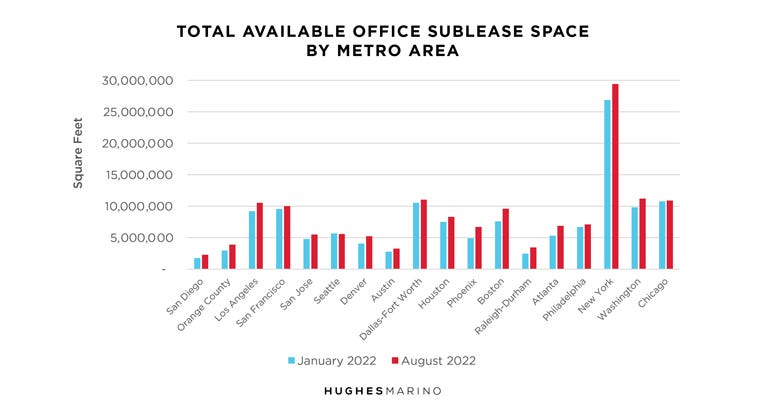
Tenants Now Compete with Landlords to Unload Space
This ballooning of sublease space is a challenge for building owners as tenants have become landlords’ toughest competition. In this unregulated industry, landlords work together cooperatively-backstopped with helpful flows of information from the brokerage community-to price support the market, and no one wants to undercut prices and lead the market down. An accumulation of sublease space in the market causes landlords and their brokers to lose pricing power and control. In some major markets like New York, Phoenix and San Jose, the sublease inventory makes up 19–22% of the total amount of office space available. For example, in San Francisco, a total of 26% of the available office space is comprised of subleases. In other major markets such as Austin, Chicago, Dallas, Denver, San Francisco and Washington DC, when you add the amount of sublease space available for lease directly from landlords, you get shockingly high availability rates at 19% or above-23% in Houston.

While we are expecting Corporate America to create an equilibrium between remote working and their office footprint needs by the end of 2023-more than a year away-there is likely to be more unloading of office space for sublease between now and then. Sublease inventory conditions could become even worse if the US enters major recession territory, in which historically more office space becomes available for sublease as layoffs and cost reductions occur.
Opportunities for Tenants
What this means for tenants with leases expiring in the next two to three years is that you’re likely to see below-market opportunities to sublease space at significant discounts to what landlords are attempting to charge. Further, these subleases are generally shorter in length than what landlords demand, and are available move-in ready as most subleases can be negotiated as “plug and play” with all of the furniture and technology infrastructure intact.
While the big full-service brokerage firms that represent primarily landlords and sometimes tenants try to support the glass floor on pricing, Hughes Marino is uniquely positioned to leverage tenants into the market with full transparency to understand their breadth of choices, and to test the market for price discovery. It takes a tenant-side position to make market conditions work best for the tenants’ benefit, as brokers at the full-service landlord firms hear the constant drumbeat of an alternative reality that the office market is active and improving-when in fact it’s not. While there are pockets of tightness and outliers in certain submarkets around the country, the good news for tenants generally is that the market is still serving up abundant choices, and the market will be favorable for tenants for many years to come.
Originally published at https://hughesmarino.com on August 17, 2022.

Growing a successful company begins with the business owner’s singular expertise. Smoothly running systems and processes provide a solid foundation for business expansion. Sales, marketing, information technology, accounting, and human resources also play key roles in the business’ growth.
What do all these business components have in common? They each depend on interactions between highly skilled team members, each with their own area(s) of expertise. When certain employees are not in their assigned roles, it’s harder to deliver quality products or provide top-notch services.
Now, imagine the global turmoil from the COVID-19 pandemic. Countless businesses shut down for months, causing thousands of layoffs across a wide range of industries. While employers sat idle or managed remote workforces, they had plenty of time to focus on more effective talent recruitment.
What’s Behind Employers’ Recruiting Problems
Although workplaces have returned to normal operations, staffing rates are still considerably below pre-pandemic levels. In my view, there’s still plenty of talent out there. However, the pandemic magnified existing recruitment problems that didn’t magically go away.
Change in Employee Work Styles
By all accounts, employees have drastically changed their work preferences. Companies across the board should ensure that they respond to these changes accordingly. That will enable these employers to more effectively recruit top talent.
More Employees Prefer Remote Work
During the pandemic’s early days, companies scrambled to provide employees with remote work infrastructure. Over time, workers (especially those with children) decided they preferred remote work’s flexibility. Almost two-thirds of American parents want to keep working remotely.
For another perspective, nearly 40 percent of employees overall would consider leaving their positions if they could not work remotely. With many workforces still not back to full strength, employers don’t want to hear that news.
To complicate the issue, certain industries depend on on-site employees to function. Examples include manufacturing operations and retail stores. To become more desirable to job seekers, some of these businesses are offering increased pay and mental health programs.
Millennials and Gen Zers Focus on Mental Health
Not surprisingly, the pandemic caused the global workforce to experience stress on multiple fronts. As a result, many job candidates have reshuffled their personal and career priorities.
Employers who want to keep current employees, and attract new ones, should offer mental health services. Workers are also seeking higher wages, fewer hours, and more paid vacation. Cash-strapped businesses should take a hard look at their priorities and decide what’s most important.
5 More Reasons Companies Are Striking Out
Many businesses are likely making one (or more) of the following recruitment and hiring errors. In today’s super-challenging job market, companies can’t afford to lose ground to competitors because of these missteps.
Dull, Boring Job Description
The online job boards are chock full of job postings for every position imaginable. A company’s job ad won’t stand out if it is poorly written with only vague details about the position. Likewise, there may be little information about salary, benefits, or the company culture. Given these negatives, the company is not likely to attract the type of candidates it wants to hire. I certainly wouldn’t respond to these substandard job ads.
Insufficient Candidate Pool
Some businesses simply don’t have enough qualified candidates in their hiring pool. The hiring process further narrows down the numbers, often leaving only scant pickings for hiring managers. Therefore, these companies might be forced to hire less-than-ideal applicants for each position.
Poor Outreach to Passive Candidates
Proactive companies don’t rely on job postings alone. Instead, these results-minded businesses contact potential candidates within the desired industry. However, the business’ outreach efforts won’t pay off if the recruiter doesn’t present the position in an attractive light.
Limited-Scope Resume Analysis
Some hiring managers look for the perfect candidate and exclude everyone who doesn’t fit that mold. As a result, the managers ignore potentially transferable skills and talents that could make a candidate a real asset. Next, add a small candidate pool to the mix. Now, the company is setting itself up for substandard results. At my company, I don’t want to fall into that trap. I always consider “out of the box” candidates who have that something special.
Recruitment and Hiring Leadership
Finally, companies may have fine-tuned the recruitment and hiring process but still aren’t finding the qualified candidates they need. Maybe it’s time to look at the elephant in the room. In other words, is the right person in charge? Whether the company handles hiring internally or uses a recruitment firm, it may be time for a change.
Recommendations for Finding “A-Level” Candidates
With a little due diligence, companies can reach the high-quality candidates they want. Hiring managers should begin with a precise (not wordy) job description that presents the position in an attractive way. Sections on career development, company culture, and work-life balance are important.
Ferreting out passive candidates is also a key piece of the puzzle. Many workers would consider switching companies if offered an enticing salary and benefits package. Also, employers should consider posting jobs on LinkedIn, industry-focused job boards, and remote job boards.
Engaging with out-of-network recruiters may also be a productive strategy. By sharing contacts and recruitment strategies, both parties may set themselves up for a win. Finally, businesses should keep freelancers in their back pockets. These versatile contractors can often pick up the slack until the right new hires are in place.

The massive glut of retail space likely has commercial developers nationwide scratching their heads for a solution. Mega-malls sit mostly vacant while many tenants calculate how long they can hang on. Neighborhood strip centers also have plenty of spaces for lease. I think I can safely say that the retail leasing business really is a buyer’s market.
Amid the large-scale carnage, two unlikely solutions have appeared. ECommerce fulfillment centers are appearing in large metro areas and small towns alike. Retail incubators are also springing up in all sorts of settings. Both developments have emerged from the country’s ongoing economic roller coaster. Here’s a deep dive into both growing trends.
What’s Behind the Surplus of Retail Space
The COVID-19 pandemic was the catalyst behind an unprecedented realignment of the retail landscape. In the pandemic’s early days, millions of workers were idled as thousands of businesses closed their doors indefinitely. Retail big box stores and locally owned shops alike were affected. Some employees occupied their time by working remotely. However, everyone found themselves with endless unstructured hours at home.
To alleviate their boredom, consumers browsed eCommerce sites and ordered massive amounts of merchandise. Online retailers ramped up their fulfillment operations, adding extra shifts and streamlining shipping cycles to meet demand. In fact, many companies were able to deliver their products almost anywhere within a couple of days.
Retail in the Post-Pandemic Era
Today, the pandemic’s effects have diminished, and the retail industry is again open for business. However, an interrelated series of events continues to completely shake up the retail landscape.
Thousands of retailers have closed their doors for good, unable to sustain operations without any sales for months. Other retail businesses have downsized, shrinking store sizes and/or consolidating outlets to eliminate marginal performers. The net effect: countless retail space has become available for rent or purchase.
Many consumers have also decided that they prefer shopping online from the comfort of home. In fact, eCommerce sales have continued to explode with no end in sight. This rapid growth has led online retailers to search for venues that could be converted into strategically placed distribution centers.
On a related note, a record number of entrepreneurs developed small business concepts during the pandemic. Now that the economy is fully open, many business owners are looking for brick-and-mortar space to expand their operations.
Two Innovative Uses for Vacant Retail Space
Two distinct markets contain much of this vacant retail square footage. Together, they can help to transform local retail wastelands into thriving business hubs.
ECommerce Distribution Centers
Online retailers’ growing need for distribution space appears to mesh with the increased amount of available retail space. Each individual space is a blank slate that can be configured to meet each eCommerce business’ specific needs. Even better, the vacant retail spaces range from single storefronts to large department or discount stores. In other words, there’s literally something for everybody.
To add another wrinkle, many surviving brick-and-mortar retailers have ramped up their eCommerce sales. These businesses also need more space for their fulfillment operations. The solution: mini-fulfillment centers located on each retailer’s premises. Ideally, these centers will be situated near customers’ communities. This helps to ensure a more efficient “last mile” in the delivery experience.
Each fulfillment center’s configuration will be different. In every operation, however, a good warehouse management system will help to streamline picking and shipping tasks. Managers should understand how eCommerce order fulfillment works. Finally, workers should receive training that enables them to efficiently perform their job tasks.
Retail Incubators
The term “retail incubator” refers to a space in which new or micro-scale retail entrepreneurs can get an initial foothold. Equally importantly, they can gain this traction without breaking the bank.
In a retail incubator setting, multiple tenants share space and operating expenses in good locations they couldn’t otherwise afford. Vacant retail spaces (especially ground floor locations) are ideal for this purpose. Bold signage and visual design will help to draw customers to each business.
Like a business incubator, a retail incubator operation provides tenants with financial, technical, business, and marketing guidance. Submarket rents are also a hallmark of retail incubator operations. Some incubator managers permit tenants to hold community events and/or engage in micro-scale manufacturing operations.
A commercial property owner or local community development corporation can launch a retail incubator. Sometimes, business partnerships spring up between unlikely collaborators with the same vision. In my view, the sky’s the limit here.
Not surprisingly, a retail incubator offers significant benefits to the community. A small-scale manufacturer can become an anchor business that draws foot traffic to nearby small retailers. A co-op vibe can energize creators and customers alike. Each business will gradually develop its own identity. As the company grows, they’ll build a following that continues to widen their circle of influence.
Most importantly, a retail incubator offers business opportunities to everyone in the community. Business owners’ wide-ranging skills and talents often complement each other. As the businesses grow, they create jobs for community residents. Taken together, these factors help to enrich the entire community for the long term.
Today’s Trends in Law Firm Office Design — Hughes Marino Seattle

Less square footage, more collaborative space and a “tech-like” feel.
That’s the verdict, as they say, in new research conducted about law firm leases over the past year in the post-pandemic era. Led by the popularity of working from home, the survey indicates many law firms have embraced the hybrid work model, and are taking the opportunity to reimagine their spaces to appeal to the multi-generational and newly embraced work life integration habits experienced over the past few years.
Since many attorneys now work from home two-to-three days a week, the overall square footage needs for many law firms has been reduced by 25%, with some individual offices decreasing by 40% — from 200 to 120 square feet. Another redesign revealed is that a number of firms are doing away with large and private offices for attorneys who are only in the office twice a week, moving instead to a hoteling system, by which office users can just “plug & play” in a specifically designated space.
Another trend impacting the industry is that more firms are now opting for universal office sizes. This new concept is not only more efficient -creating 50 private offices in the same space that used to have 42, for instance — but it removes the sense of hierarchy, and the large corner-office status of leadership. Overall, workstations are shrinking too, with the average unit being reduced by 33%.

Evolving technology has also inspired other changes in law firm office spaces. The once-ubiquitous law library has been digitized, allowing for the transformation of the space that used to be dedicated to shelves of books, to becoming a lounge area with high-end comfortable seating and coffee tables — a place for connection and collaboration. Traditional conference rooms have also undergone a tech transformation as Zoom calls have become the norm. Many meeting spaces have been specially outfitted for video meetings with sophisticated audio and video capabilities, to maintain legalese performance.
Along with these physical changes has come an innovation in visual design as well. Gone are the dark woods and solid walls of yesteryear. Today’s offices are outfitted with glass walls and doors, allowing for the flow of natural light to brighten the entire space. Walls are decorated with colorful works of art and modern interior design elements. High-end, upgraded and full-size kitchens give the office a feeling more like home, and also allows for cooking and a place to connect with colleagues.
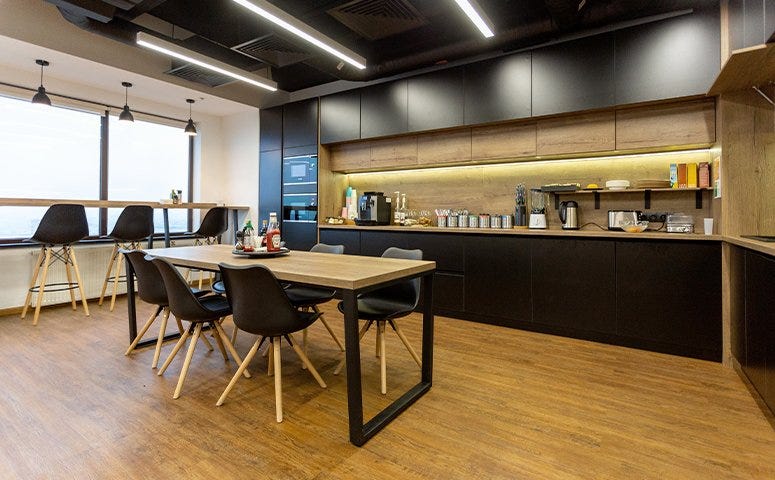
Having communal spaces for interaction is important for younger attorneys who are always seeking mentorship and acceptance opportunities with all levels. Being able to attract and retain younger legal talent is one reason for this new design trend of less “conservative corporate” and more “cool tech titan,” and is very much needed within the industry. Think about it — if you’re signing a 10-year lease today, the junior attorneys you’ll have in 10 years are currently in high school! To attract new talent, a space needs to be modern, high-tech and exciting, and should provide the same elements and features they’ve grown accustomed to at their high schools and universities.
These trends are all aspects of a reinspired office space that law firms should to consider to be the most competitive and successful. A best approach is to start the renovation process at least 18 months prior to the current lease expiration, having decision-makers connect with an architect, who may need to spend two or three months analyzing the square footage needs.
Another major concept to consider is how a firm will embrace remote work. What will that look like at your firm? Will you convert to standard-size offices or keep a few larger spaces for senior partners? How does the technology capacity and utilization need to evolve? This process can take longer than you might expect, depending on how quickly the decision-makers can come to an agreement.
We encourage you to take a look at the research and know what the trends and possibilities are while keeping your future needs at the forefront. The model of hybrid work has already brought many changes to the law office landscape, and other transformations could be right around the corner. To create a space that will retain and attract the brightest legal minds of tomorrow, it’s best to start planning today.
At Hughes Marino, we pride ourselves on being a valuable partner in negotiating a lease, planning, design and construction project management. Our experts are knowledgeable about today’s law firm leases and trends, and know the best practices to guide your firm to the best spaces for your continued growth and success.
Gavin Curtis is senior vice president at Hughes Marino, an award-winning commercial real estate company with offices across the nation. Contact Gavin at 1–844–662–6635 or gavin@hughesmarino.com to learn more.
Originally published at https://hughesmarino.com on August 2, 2022.
